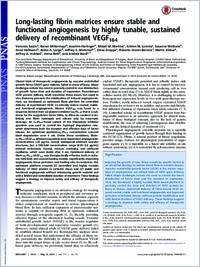Long-lasting fibrin matrices ensure stable and functional angiogenesis by highly tunable, sustained delivery of recombinant VEGF164.
- Sacchi V Cell and Gene Therapy, Department of Biomedicine, University of Basel, and Department of Surgery, Basel University Hospital, CH-4031 Basel, Switzerland;
- Mittermayr R Ludwig Boltzmann Institute for Experimental and Clinical Traumatology, Austrian Cluster for Tissue Regeneration, Allgemeine Unfallversicherungsanstalt, A-1200 Vienna, Austria;
- Hartinger J Ludwig Boltzmann Institute for Experimental and Clinical Traumatology, Austrian Cluster for Tissue Regeneration, Allgemeine Unfallversicherungsanstalt, A-1200 Vienna, Austria;
- Martino MM Institute of Bioengineering, School of Life Sciences and School of Engineering, Ecole Polytechnique Fédérale de Lausanne, CH-1015 Lausanne, Switzerland;
- Lorentz KM Institute of Bioengineering, School of Life Sciences and School of Engineering, Ecole Polytechnique Fédérale de Lausanne, CH-1015 Lausanne, Switzerland;
- Wolbank S Ludwig Boltzmann Institute for Experimental and Clinical Traumatology, Austrian Cluster for Tissue Regeneration, Allgemeine Unfallversicherungsanstalt, A-1200 Vienna, Austria;
- Hofmann A Ludwig Boltzmann Institute for Experimental and Clinical Traumatology, Austrian Cluster for Tissue Regeneration, Allgemeine Unfallversicherungsanstalt, A-1200 Vienna, Austria;
- Largo RA Departments of Urology and.
- Marschall JS Obstetrics, Zurich University Hospital, CH-8091 Zurich, Switzerland; andUniversity of Louisville School of Dentistry, Louisville, KY 40202.
- Groppa E Cell and Gene Therapy, Department of Biomedicine, University of Basel, and Department of Surgery, Basel University Hospital, CH-4031 Basel, Switzerland;
- Gianni-Barrera R Cell and Gene Therapy, Department of Biomedicine, University of Basel, and Department of Surgery, Basel University Hospital, CH-4031 Basel, Switzerland;
- Ehrbar M Obstetrics, Zurich University Hospital, CH-8091 Zurich, Switzerland; and.
- Hubbell JA Institute of Bioengineering, School of Life Sciences and School of Engineering, Ecole Polytechnique Fédérale de Lausanne, CH-1015 Lausanne, Switzerland;
- Redl H Ludwig Boltzmann Institute for Experimental and Clinical Traumatology, Austrian Cluster for Tissue Regeneration, Allgemeine Unfallversicherungsanstalt, A-1200 Vienna, Austria;
- Banfi A Cell and Gene Therapy, Department of Biomedicine, University of Basel, and Department of Surgery, Basel University Hospital, CH-4031 Basel, Switzerland; Andrea.Banfi@usb.ch.
- 2014-04-30
Published in:
- Proceedings of the National Academy of Sciences of the United States of America. - 2014
Animals
Female
Fibrin
Gels
Gene Transfer Techniques
Genetic Therapy
Hindlimb
Human Umbilical Vein Endothelial Cells
Humans
Ischemia
Mice
Mice, Inbred Strains
Mice, SCID
Muscle, Skeletal
Neovascularization, Physiologic
Recombinant Proteins
Vascular Endothelial Growth Factor A
English
Clinical trials of therapeutic angiogenesis by vascular endothelial growth factor (VEGF) gene delivery failed to show efficacy. Major challenges include the need to precisely control in vivo distribution of growth factor dose and duration of expression. Recombinant VEGF protein delivery could overcome these issues, but rapid in vivo clearance prevents the stabilization of induced angiogenesis. Here, we developed an optimized fibrin platform for controlled delivery of recombinant VEGF, to robustly induce normal, stable, and functional angiogenesis. Murine VEGF164 was fused to a sequence derived from α2-plasmin inhibitor (α2-PI1-8) that is a substrate for the coagulation factor fXIIIa, to allow its covalent cross-linking into fibrin hydrogels and release only by enzymatic cleavage. An α2-PI1-8-fused variant of the fibrinolysis inhibitor aprotinin was used to control the hydrogel degradation rate, which determines both the duration and effective dose of factor release. An optimized aprotinin-α2-PI1-8 concentration ensured ideal degradation over 4 wk. Under these conditions, fibrin-α2-PI1-8-VEGF164 allowed exquisitely dose-dependent angiogenesis: concentrations ≥25 μg/mL caused widespread aberrant vascular structures, but a 500-fold concentration range (0.01-5.0 μg/mL) induced exclusively normal, mature, nonleaky, and perfused capillaries, which were stable after 3 mo. Optimized delivery of fibrin-α2-PI1-8-VEGF164 was therapeutically effective both in ischemic hind limb and wound-healing models, significantly improving angiogenesis, tissue perfusion, and healing rate. In conclusion, this optimized platform ensured (i) controlled and highly tunable delivery of VEGF protein in ischemic tissue and (ii) stable and functional angiogenesis without introducing genetic material and with a limited and controllable duration of treatment. These findings suggest a strategy to improve safety and efficacy of therapeutic angiogenesis.
- Language
-
- English
- Open access status
- bronze
- Identifiers
-
- DOI 10.1073/pnas.1404605111
- PMID 24778233
- Persistent URL
- https://sonar.ch/global/documents/211949
Statistics
Document views: 16
File downloads:
- fulltext.pdf: 0
